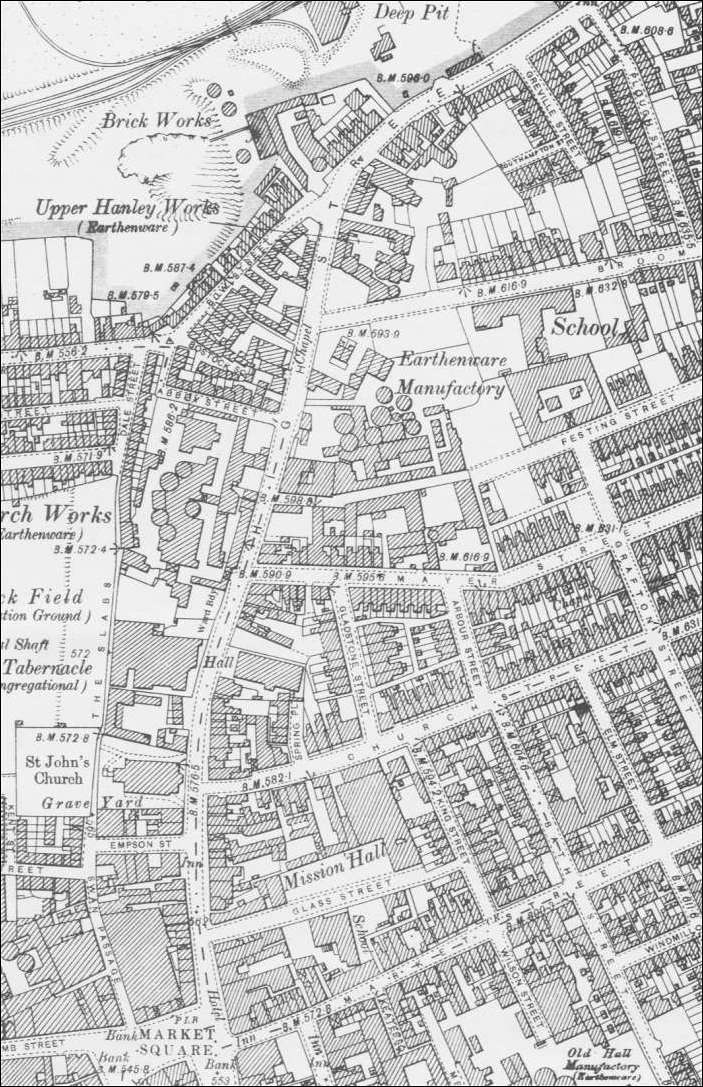![]()
Cobden Works, High Street, Hanley, Stoke-on-Trent
| From | To | Occupier | Comments |
| 1784 | 1805 | Elijah Mayer | |
| 1805 | 1834 | Elijah Mayer & Son | |
| Joseph Mayer | also Joseph Mayer & Son | ||
| Joseph Mayer & Co | |||
| 1867 | 1876 | Gelson Brothers | |
| 1876 | 1881 | Thomas Gelson & Co | |
| 1881 | 1885 | James Bevington | Previously James was in partnership with his brother Thomas. After the split of the partnership James operated from works in the High Street (Cobden Works) and King Street. |

1898 OS map showing High Street
Cobden Works, High Street
These works formed a part of those founded in the latter part of the eighteenth century by Elijah Mayer, who in about 1805 took his son into partnership under the style of Elijah Mayer & Son (1805-34). It was afterwards Joseph Mayer and Joseph Mayer & Co.
Elijah Mayer was a potter of considerable eminence, and he produced an extensive variety of goods. His Egyptian black or basalt ware was, in quality of body, nearly equal to that of Wedgwood, and the ornamentation was sharp and well defined; in this, he produced teapots, cream-ewers, bowls, and other articles. In cream-coloured ware, services and all the usual useful articles were made, and were of unusually good style and quality. For these and his 'brown line' patterns he was noted. His cane-coloured or drab unglazed goods were another of his famous productions. Elijah Mayer produced a service commemorative of Nelson's Trafalgar and Nile victories which became very popular.
His mark was 'E.Mayer' impressed in the ware, and afterwards 'E.Mayer & Son'.
Of the later firm, some examples with the name Joseph Mayer & Co. Hanley , are recorded.In 1867, the premises were purchased by Gelson Brothers, who in 1876 dissolved partnership, the business being conducted by Thomas
Gelson & Co., who in 1881 were succeeded by James Bevington (previously of J. & T. Bevington), who produced to a large extent and in great
variety all the usual classes of decorated china and fancy goods. James Bevington continued to 1885.Messrs. Gelson & Co., who originally made white granite-ware for the American markets, abandoned that branch and confined themselves to the production of the highest classes of useful goods for the home trade. In this, they made dinner, tea, breakfast, toilet and other services in every variety of printed, enamelled and guilt patterns.
One of their specialities was the successful imitation of the old Dresden style. Another of their decorative ideas was the introduction of Anglo-Saxon and early Irish interlaced ornaments in bands encircling mouth-ewers and other articles.
Jewitt's Ceramic Art of Great Britain 1800-1900
![]()
Questions/comments/contributions? email: Steve Birks
26 Dec 2005